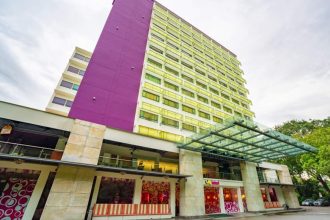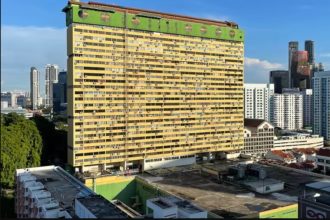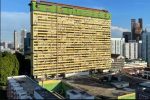Key takeaway
Colin St Clair Oakes, a war veteran and British architect, designed Singapore’s Kranji War Cemetery and its Singapore Memorial in 1957. His design echoes his experience in conflict, using a modernist form shaped like an aircraft to honour more than 24,000 missing Allied servicemen. The memorial reflects his deep respect for sacrifice and his unique architectural voice born of war.
The northern hill of Singapore at Kranji holds a quiet power. Overlooking the Johor Straits, the grassy slopes of the Kranji War Cemetery seem peaceful, but every stone, every name, every structure whispers stories of loss and remembrance. At the heart of that site is the Singapore Memorial, the work of architect Colin St Clair Oakes. In 1957, his design was unveiled to commemorate Allied servicemen with no known graves. But who was Oakes, and how did he shape something so emotionally profound?
The man behind the design: Colin St Clair Oakes
Colin St Clair Oakes was a British architect who served in the Second World War. He rose to become a Principal Architect with the Commonwealth War Graves Commission. His personal experience in wartime, including service in Burma, deeply shaped his architectural vision.
Born in Wales on 23 May 1908, Oakes studied architecture and later joined the Territorial Army. After the war, the War Graves Commission sent him to tour war‑torn regions in Asia to assess sites and design memorials. He went on to design multiple cemeteries across South and Southeast Asia, but his work in Singapore remains among his most iconic.
Why Kranji was chosen, and what the site meant
The hill at Kranji was not random. During the war, it was the location of a POW camp and a makeshift hospital. After 1945, the Commonwealth War Graves Commission decided to centralise the graves of Allied personnel from across Singapore’s battlefields, POW camps, and even from other countries like Vietnam. That choice created a meaningful resting place, both geographically and symbolically. Visitors interested in Singapore’s wider history may also reflect on the story of Singapore’s failed theme park as another chapter in the nation’s changing landscape.
Designing the memorial in 1957: Oakes’s vision
On 2 March 1957, the Singapore Memorial was officially unveiled by Sir Robert Black, then Governor of Singapore. Oakes had shaped a structure that would honour missing servicemen in a deeply symbolic way. The memorial has 12 stone-clad columns, rising under a flat, wing-shaped roof. At its heart is a 22-metre central pylon capped with a star.
That form is not decoration; it is deeply symbolic. The roof evokes the wings of an airplane, representing the Air Force. The tall pylon suggests tail fins, or even a star rising. The columns march like soldiers in formation: a nod to the Army. The overall geometry also suggests a submarine’s conning tower, a salute to the Navy.
Inscribing sacrifice
The twelve columns bear the names of more than 24,000 Allied servicemen whose remains were never found. Oakes designed the memorial so that visitors feel both the absence and presence; the names are there, but the missing individuals are gone. Those interested in Singapore’s architectural legacy might also consider the nearby abandoned royal palace for a complementary story of historic sites.
The Kranji War Cemetery around the memorial
The Kranji War Cemetery does not just hold the memorial. There are more than 4,400 graves, mainly from World War II. Many of the graves are marked by white headstones, uniformly designed, regardless of rank or nationality.
Other memorials within the site also commemorate different groups:
- The Chinese Memorial: a collective grave for 69 Chinese servicemen.
- The Singapore (Unmaintained Graves) Memorial: for those whose graves could not be preserved.
- The Singapore Cremation Memorial: mostly for Indian servicemen whose remains were cremated.
- The Singapore Civil Hospital Grave Memorial: for over 100 Commonwealth servicemen and civilians who died in a POW hospital and were buried in a mass grave.
Landscaping and Flora at Kranji
Oakes did not design the memorial in isolation; the surrounding landscape plays a crucial role in creating the solemn atmosphere. The cemetery features gentle slopes and manicured lawns, punctuated by native trees like frangipani, casuarina, and angsana. These trees provide shade, frame the memorial, and create a peaceful rhythm as visitors walk through the grounds. Carefully placed pathways guide visitors between graves, ensuring accessibility and contemplation. Seasonal flowering adds subtle color, while open sightlines maintain the feeling of openness and reflection. The landscaping complements Oakes’s architectural geometry, balancing human-made structures with nature to honour those who sacrificed their lives.
Key design principles Oakes used in Kranji War Cemetery
- Uniform commemoration: Every headstone is identical, symbolizing equality of sacrifice.
- Symbolic architecture: The 12 columns and winged roof evoke different military branches, while the central pylon reaches skyward like a tail fin or star.
- Modern yet solemn form: Oakes embraced modernist geometry without sacrificing the solemn dignity suited for a war memorial.
- Landscape integration: The memorial sits at the hilltop, overlooking the cemetery and naturally integrated into its surroundings. This honors the fallen in a place of stillness.
- Inclusivity of sacrifice: Names from multiple nations, services, and faiths are included, a reflection of the Commonwealth’s diversity.
How do people respond to the memorial today?
Over the years, the Kranji War Cemetery and the Singapore Memorial have become important sites of remembrance. Annual services like Remembrance Day and ANZAC Day draw visitors from Singapore and abroad.
The design still feels alive. Visitors often comment on how the wings of the roof frame the sky, how climbing the steps to the pylon feels like rising in memory. The names etched on the columns connect people to individuals from distant lands, long missing but never forgotten. Walking through the cemetery also recalls other Singapore landmarks along old routes, like the historic green corridor, showing the layers of the nation’s history.
Kranji War Cemetery: Educational and Commemorative Activities
Kranji War Cemetery is not just a site for quiet reflection. Educational programs and guided tours are regularly conducted to teach students and visitors about World War II and Singapore’s role in the conflict. Commemorative events like Remembrance Day ceremonies engage the public, reinforcing historical memory. The cemetery also encourages research and genealogical study, allowing families to trace relatives and learn their stories. Interpretive signs provide context about the design, the servicemen, and the Commonwealth’s military contributions. These activities transform the site from a static memorial into an active learning environment, preserving history for future generations while fostering empathy and understanding.
Table: Snapshot of Kranji War Cemetery and Singapore Memorial
| Feature | Details | Significance | Sources |
|---|---|---|---|
| Number of graves | ~ 4,400 graves | Resting place for Allied servicemen from WWII | Official cemetery records |
| Architect | Colin St Clair Oakes | Designer of both cemetery layout and memorial | Official archives |
| Memorial type | Singapore Memorial (columns + winged roof + central pylon) | Commemorates more than 24,000 missing | Official memorial information |
Reflections on Colin St Clair Oakes’s 1957 memorial
When you walk up the grassy slope towards the Kranji Memorial, you may not see Oakes’s name at first glance. But what you do see is what he intended: a structure that is modest, clear, and meaningful. The wing-like roof, the tall pylon, the pillars … they combine into a quiet gesture of tribute.
In shaping Singapore’s war memorial in 1957, Oakes gave form to loss, memory, and hope. His life as a soldier and architect merged into a design that still stands strong. Visitors today can learn more about the design and names inscribed at the Allied servicemen memorial, ensuring that Oakes’s work continues to educate and inspire.








